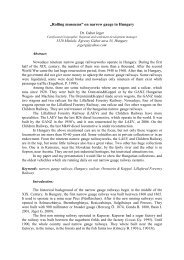'Representing Difficult Pasts within Complex Presents ... - T2M
'Representing Difficult Pasts within Complex Presents ... - T2M
'Representing Difficult Pasts within Complex Presents ... - T2M
Create successful ePaper yourself
Turn your PDF publications into a flip-book with our unique Google optimized e-Paper software.
transport as people had to commute further and further to work 39 ? What about interactive exhibits,<br />
transport rides, the pensioner in uniform who delivers tickets to children without problematising the past.<br />
Should one focus on (as Divall puts it) the BLO’s (Big Lumpy Objects) in South Africa as key attractors,<br />
known to work well in UK transport museums, or AVC’s (Astounding Virtual Constructions – - my own<br />
terminological creation) instead? Or both?<br />
28<br />
Technology and Science, and the social sciences are often perceived to be theoretically far apart,<br />
difficult to merge in theory (see Mitchell 1998). Through focusing merely on one aspect, we ignore<br />
multiple other interpretations, thus creating a narrative that potentially excludes. Should one display<br />
collections of motor vehicles to populations who may not ever possess a vehicle of their own, as a<br />
constant reminder of what one does not have, or as representing possibilities – desire and dreams and<br />
fantasies for what maybe for what one might have, one day. Would people want to come to the museum<br />
because of this?<br />
Interestingly there is a motor vehicle event that takes place at Good Hope Centre in Cape Town<br />
annually, in which panel beaters display and win prizes for converted vehicles which draws on an<br />
audience primarily from ‘coloured’ residential areas, and certainly involves creativity, uniqueness and<br />
artistry in relation to vehicles. Perhaps a museum of Transport could incorporate events or reference to<br />
activities such as these? What about the well-known bicycle and running competitions in Cape Town such<br />
as the Argus? Can artworks also be used, as the burnt out bus of Roger Meintjes, or artists brought in to<br />
create new works, who, as Schneider (2003; also see Schneider and Wright 2010; 2006) argues, research<br />
in a manner similar to anthropologists in society. Artists, as in District Six museum, could also be part of<br />
work-shopping the museum's construction, presenting more imaginative, playful interactions with the<br />
public that seek to interpret and interrogate transport realities, not as add-on art exhibits to collections<br />
already present, or as decorative pieces, but as part of planning and creative thinking around specific<br />
exhibitions. Should there even be an archive? If so, what objects or texts should be included and who<br />
should have control and access over them?<br />
Certainly, as Hostel 33 shows, the ‘real thing’ has considerable impact. But the high tech virtual<br />
environment can also have impact. A concept where individuals can experience, say, an actual bus, - the<br />
‘real thing’ - and move handles, knobs etc while taking a ‘virtual’ tour of Cape Town in the past and<br />
present could be exciting. Interactive maps on walls could show changing routes and places over time,<br />
39 Uma Mesthrie is writing about the Black River Community and the relationship of the Black River<br />
Golden Arrow Depot to forced removals (as yet unpublished), for related published work on Black River by<br />
Mesthrie see Mesthrie 2000)




